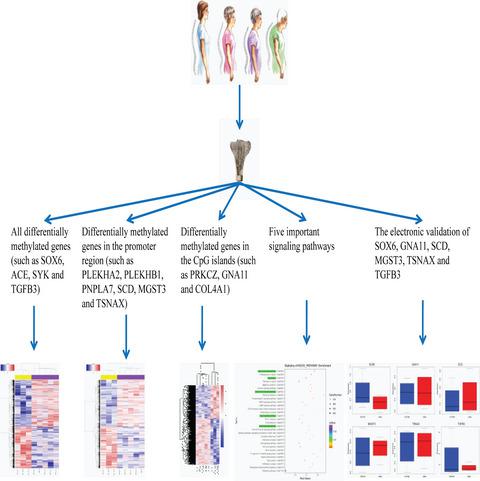当前位置:
X-MOL 学术
›
FEBS Open Bio
›
论文详情
Our official English website, www.x-mol.net, welcomes your
feedback! (Note: you will need to create a separate account there.)
Alterations in DNA methylation profiles in cancellous bone of postmenopausal women with osteoporosis.
FEBS Open Bio ( IF 2.8 ) Pub Date : 2020-06-26 , DOI: 10.1002/2211-5463.12907 Yu Zhou 1 , Ling Yang 1 , Hong Wang 1 , Xi Chen 1 , Wei Jiang 1 , Zhicong Wang 1 , Shuping Liu 1 , Yuehong Liu 1
FEBS Open Bio ( IF 2.8 ) Pub Date : 2020-06-26 , DOI: 10.1002/2211-5463.12907 Yu Zhou 1 , Ling Yang 1 , Hong Wang 1 , Xi Chen 1 , Wei Jiang 1 , Zhicong Wang 1 , Shuping Liu 1 , Yuehong Liu 1
Affiliation

|
Osteoporosis is characterized by systemic microarchitecture impairment and bone loss, which ultimately lead to fragility fractures. This disease is most common in older people, especially in postmenopausal women. Cancellous bone is affected by osteoporosis earlier than cortical bone, and DNA methylation microarray analysis of the hip cancellous bone of patients with osteoarthritis revealed differential methylation. In view of the important role of cancellous bone in bone development, we examined genome‐wide DNA methylation profiles in the cancellous bone from patients with postmenopausal osteoporosis versus healthy postmenopausal women using Illumina 850K methylation microarray analysis. Under a threshold of P < 0.05, we obtained a total of 8973 differentially methylated genes, such as SOX6, ACE, SYK and TGFB3. Under a threshold of P < 0.05 and |△β| > 0.2, a total of 17 and 34 key differentially methylated genes were further identified at the promoter region and cytosine‐ phosphate‐ guanine (CpG) islands (such as PRKCZ, GNA11 and COL4A1), respectively. PLEKHA2, PLEKHB1, PNPLA7, SCD, MGST3 and TSNAX were the most common differentially methylated genes at both the promoter region and CpG islands. Five important signaling pathways, including the calcium signaling pathway, the cyclic guanosine phospho‐protein kinase G (cGMP‐PKG) signaling pathway, endocytosis, the Rap1 signaling pathway and the AMPK signaling pathway were identified. Our study may be suitable as a basis for exploring the mechanisms underlying osteoporosis in postmenopausal women.
中文翻译:

患有骨质疏松症的绝经后妇女松质骨中 DNA 甲基化谱的改变。
骨质疏松症的特点是全身微结构损伤和骨质流失,最终导致脆性骨折。这种疾病最常见于老年人,尤其是绝经后妇女。松质骨比皮质骨更早受到骨质疏松症的影响,骨关节炎患者髋关节松质骨的 DNA 甲基化微阵列分析显示差异甲基化。鉴于松质骨在骨骼发育中的重要作用,我们使用 Illumina 850K 甲基化微阵列分析检查了绝经后骨质疏松症患者与健康绝经后妇女的松质骨中的全基因组 DNA 甲基化谱。在P < 0.05的阈值下,我们总共获得了 8973 个差异甲基化基因,例如SOX6、ACE、SYK和TGFB3。在P < 0.05 和 |△β|的阈值下 > 0.2,分别在启动子区和胞嘧啶-磷酸-鸟嘌呤(CpG)岛(如PRKCZ、GNA11和COL4A1)进一步鉴定了总共 17 个和 34 个关键的差异甲基化基因。PLEKHA2、PLEKHB1、PNPLA7、SCD、MGST3和TSNAX是启动子区和 CpG 岛最常见的差异甲基化基因。鉴定了五种重要的信号通路,包括钙信号通路、环鸟苷磷蛋白激酶 G (cGMP-PKG) 信号通路、内吞作用、Rap1 信号通路和 AMPK 信号通路。我们的研究可能适合作为探索绝经后妇女骨质疏松症潜在机制的基础。
更新日期:2020-06-26
中文翻译:

患有骨质疏松症的绝经后妇女松质骨中 DNA 甲基化谱的改变。
骨质疏松症的特点是全身微结构损伤和骨质流失,最终导致脆性骨折。这种疾病最常见于老年人,尤其是绝经后妇女。松质骨比皮质骨更早受到骨质疏松症的影响,骨关节炎患者髋关节松质骨的 DNA 甲基化微阵列分析显示差异甲基化。鉴于松质骨在骨骼发育中的重要作用,我们使用 Illumina 850K 甲基化微阵列分析检查了绝经后骨质疏松症患者与健康绝经后妇女的松质骨中的全基因组 DNA 甲基化谱。在P < 0.05的阈值下,我们总共获得了 8973 个差异甲基化基因,例如SOX6、ACE、SYK和TGFB3。在P < 0.05 和 |△β|的阈值下 > 0.2,分别在启动子区和胞嘧啶-磷酸-鸟嘌呤(CpG)岛(如PRKCZ、GNA11和COL4A1)进一步鉴定了总共 17 个和 34 个关键的差异甲基化基因。PLEKHA2、PLEKHB1、PNPLA7、SCD、MGST3和TSNAX是启动子区和 CpG 岛最常见的差异甲基化基因。鉴定了五种重要的信号通路,包括钙信号通路、环鸟苷磷蛋白激酶 G (cGMP-PKG) 信号通路、内吞作用、Rap1 信号通路和 AMPK 信号通路。我们的研究可能适合作为探索绝经后妇女骨质疏松症潜在机制的基础。











































 京公网安备 11010802027423号
京公网安备 11010802027423号